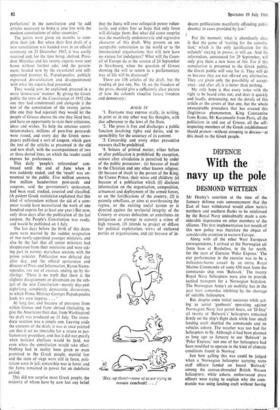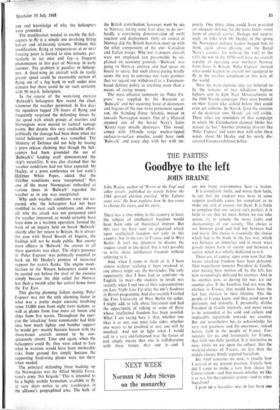With the navy up the pole
DEFENCE DESMOND WETTERN
Mr Healey's assertion at the time of• the January defence cuts announcement that the East of Suez withdrawal would allow tre-rp's northern and southern flanks to be reinforced by the Royal Navy undoubtedly made a con- siderable impression on other members of the alliance. The first implementation last month of this new policy was therefore the object of considerable attention in western Europe.
Along with all the other West European correspondents, I arrived at the Norwegian air force base at Bardufoss, in the far north, for the start of Exercise 'Polar Express.' The star performance in the exercise was to be a helicopter-borne assault by an entire Royal Marine Commando of some 650 men from the commando ship HMS 'Bulwark.' The twenty Royal Navy helicopters were also to provide tactical transport for a Norwegian battalion. The Norwegian Army's air mobility has in the past been somewhat inhibited by the shortage of suitable helicopters.
But, despite some initial successes while act- ing as aerial `gunboats' operating against Norwegian Navy fast patrol boats, on 'D-Day' all twenty of 'Bulwark's' helicopters remained firmly on the ship's flight deck while four small landing craft shuttled the commando and its vehicles ashore. The weather was too bad for helicopters to fly. Although it had been planned as long ago as January to use 'Bulwark' in 'Polar Express,' not one of her helicopters had been modified to operate in the kind of climatic conditions found in Norway.
Just how galling this was could be judged when a Norwegian helicopter carrying NATO staff officers landed on board 'Bulwark' among the canvas-shrouded British Wessex helicopters; while ashore, embarrassed press officers were trying to explain why the com- mando was using landing craft without having
any real knowledge of why the helicopters were grounded.
The modification needed to enable the heli- copters to fly is a simple one involving fitting hot-air and oil-heating systems. Without this modification, flying at temperatures at or near freezing point is limited to nine minutes, par- ticularly in icy mist and fog—a frequent phenomenon in this part of Norway in early summer. The problem is peculiar to helicop- ters. A fixed-wing jet aircraft with its vastly greater speed could be reasonably certain of flying out of a fog bank in well under nine minutes but there could be no such certainty with 90 m.p.h. helicopters.
In the course of the week-long exercise 'Bulwark's helicopters flew round the clock whenever the weather permitted. In five days the squadron logged 276 hours of flying and frequently surprised the defending forces by the speed with which groups of marines and Norwegians were moved to tactical vantage points. But despite this very creditable effort.
politically the damage had been done when the initial helicopter assault was cancelled. The Ministry of Defence did not help by issuing a press release claiming that though the heli- copters had been grounded the use of `Bulwark's' landing craft demonstrated the ship's versatility. It was also claimed that the weather conditions had not been expected. Mr Healey, at a press conference on last week's
Ornce White Paper, added that the wether conditions were 'exceptional.' Not
one of the many Norwegians embarked at various times in 'Bulwark' regarded the weather as in any way exceptional.
Why such weather conditions were not ex- pected, why the helicopters had not been modified to meet such conditions and, above
dll, why the attack was not postponed until the weather improved, as would certainly have been. done in a wartime operation, formed the
basis of an inquiry held on board 'Bulwark' shortly after her return to Britain. As is always the case with Naval Boards of Inquiry, the findings will not be made public. But among most officers in 'Bulwark' the answer to all these questions was clear. The ship's presence in 'Polar Express' was politically essential to back up Mr Healey's promise of increased
support for NATO'S flanks. The engine modi-
fication to the Wessex helicopters could not be carried out before the start of the exercise simply because the ship sailed for Norway less than a month after her arrival home from the Far East.
This glaring planning failure during 'Polar Express' was not the only alarming factor in what was a pretty major exercise involving some 15,000 men from eight NATO nations, as well as planes from four NATO air forces and ships from five navies. Throughout the exer- cise the 'attacking' force commander had little idea how much fighter and bomber support he would get—mainly because liaison with the shore-based aircraft seemed to be con- spicuously absent. Time and again, when the helicopters could fly, they were asked to face what in wartime would have been intolerable risks from ground fire simply because the supporting fixed-wing planes were not there when needed.
The principal defending force backing up the Norwegians was the Allied Mobile Force, NATO'S army 'fire brigade.' This is intended to be a highly mobile formation, available to fly at very short notice to any troublespot in the alliance's geographical area. The bulk of the British contribution, however, went by sea to Norway, taking some four days to do so— hardly a convincing demonstration of swift reaction and deployment. Only on arrival in Norway did the British battalion meet up with the other components of the AMF—Canadian and Italian troops. Why RAF transport aircraft were not employed can presumably be ex- plained on economy grounds—'Bulwark' was going to Norway anyway and had space on board to spare; but such cheese-paring hardly seems the way to convince our NATO partners that we regard our withdrawal to a European- based defence policy as anything more than a means of saving money.
The most effective comment on 'Polar Ex- press' was supplied by the Russians as 'Bulwark' and her escorting force of destroyers and frigates of the new NATO permanent squad- ron, the Standing Force Atlantic, moved in towards Norwegian waters. Out of a blizzard steamed one of the Soviet Navy's latest `Kresta--type missile destroyers. This vessel, armed with 350-mile range nuclear-tipped surface-to-surface missiles, could have sunk `Bulwark' and every ship with her with im- punity. One thing alone could have provided an adequate defence for the NATO force—some form of aircraft carrier. Perhaps not surpris- ingly, in talks with Mr Healey in the spring the Norwegian defence leaders begged him to think again about phasing out the Royal Navy's carriers, for without the TsR2 or the F11 I the RAP in the 1970s will have no aircraft capable of operating over northern Norway from bases in Britain. 'Polar Express' showed what could happen to aircraft not equipped to fly in the weather conditions in this part of the world.
Near the main exercise area arc believed to lie the remains of two Gladiator biplane fighters sent to fight Nazi Messerschmitts in the 1940 Narvik campaign. They were bombed on their frozen lake airfield before they could even get airborne. In Narvik fjord the remains of the destroyer HMS 'Hardy' arc still visible. These relics are reminders of that campaign in which Mr Chamberlain claimed 'Hitler has missed the bus.' Another planning disaster like `Polar Express and NATO may well echo these words about Mr Healey and his newly dis- covered European defence policy.







































 Previous page
Previous page